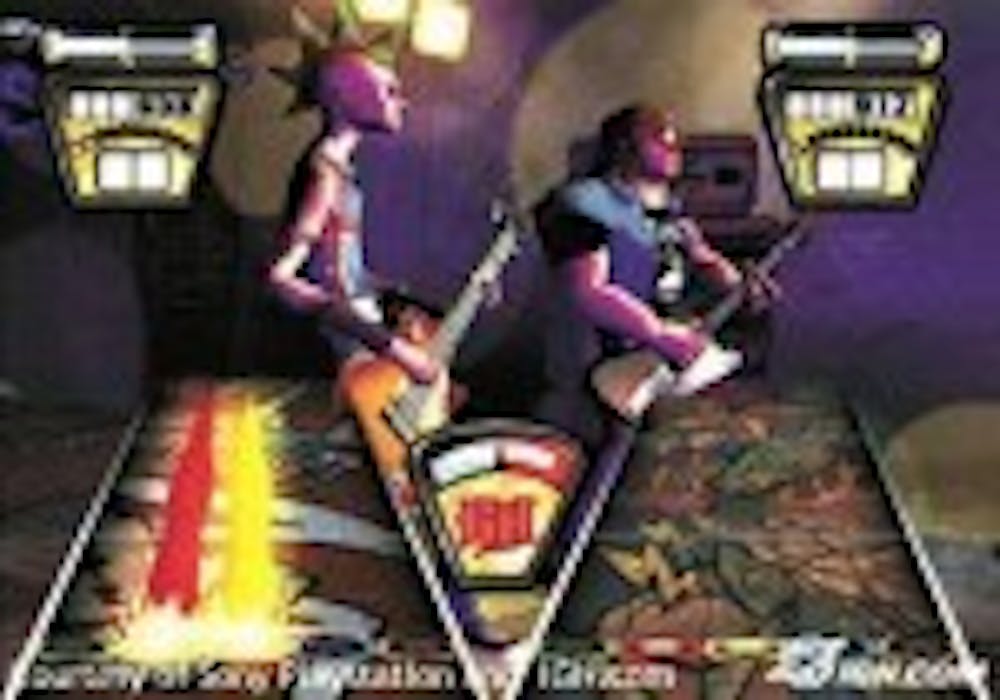Somewhere around 20 Christmases ago, pimply-faced teens were asking their parents for amps and axes. This generation, they're asking for "Guitar Hero II."
Sony released the sequel to "Guitar Hero" for PlayStation 2 in November to coincide with the shopping fever wrought about by the holiday season. The package comes complete with a dwarf-sized guitar meant to mimic the Gibson SG (which was also available for Christmas, but no one seemed to care).
In case consumers haven't heard of "Guitar Hero" yet, have no fear, it doesn't involve battling dragons with melodic spells cast from an enchanted guitar. The game is half as imaginative as any Teenage Mutant Ninja Turtle paraphernalia, which also means it's half as ridiculous.
The controller has two parts: five colored fret buttons and a button that constitutes as the strings. As a song plays, chords and notes appear on the screen and the player must echo their movement with the song's denotation. If a player misses a note the song is briefly interrupted by an innocuous beep.
If a player is doing exceptionally well, they gain star power and can tilt the guitar to release the stored up pizzazz, which causes the audience to fawn over your slick-haired rock mongrel onscreen. Every performance is rated and scored while "Guitar Hero II" includes more detailed stats for those who are concerned with polishing their finger picking.
In this updated release, players can choose a variety of modes: Cooperative, Face-Off, Pro Face-Off, Career, or Practice. It remains a mystery as to why someone would opt to play this game by their lonesome, but the bonus features are only available to those who dedicate themselves to a career of dive bars and recliners.
The Cooperative modes allow electronic strummers to choose from lead guitar, bass, or rhythm guitar parts. Through this feature develops a modest camaraderie between players, sort of what one would expect from a game of craps at the local casino.
"Guitar Hero II" includes songs by Nirvana, Stone Temple Pilots, Primus, Rolling Stones, Butthole Surfers, Spinal Tap, Van Halen and many more artists that most listened to in fifth-grade. By choosing to play the career mode heroes can eventually earn money while touring on the road and using it to purchase bonus tracks.
All together there are 88 songs that are available as a custom designed character or one of the eight provided. However, some characters must be unlocked. The new features range from three-button chords to a vibrating fret board.
Parents should be partially relieved that this game is about mastery and not murder, but beware, it's just as infectious.
Even though every video game is initially engaging, its jingles will eventually aggravate the senses and the finger gymnastics will drain gamers' supply of pizza pockets. The ingenious appeal of "Guitar Hero II" is that even after players cross that threshold, the music remains versatile and halfway decent. In other words, one can withstand playing this game longer than they could Mario Kart.
Even though the game is unvisited by violence, it subtly references the illicit lifestyle of a hair-metal band by way of obnoxious segue skits. Wittiness is unwanted here.
What could be more quintessentially post-modern than a fake-guitar game that is almost as challenging as playing a real instrument? It's tempting to say that being exceptionally good at "Guitar Hero" is an art form, similar to how Dance Dance Revolution has developed its own subculture.
What remains to be explored is why someone would choose a fake guitar over a real one. Not being able to delay self-gratification, duh!





